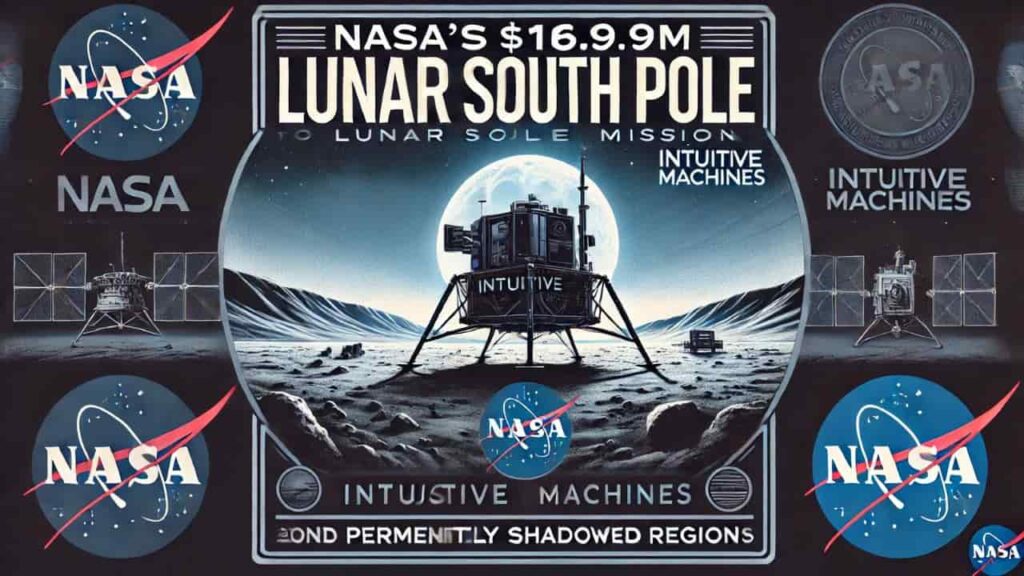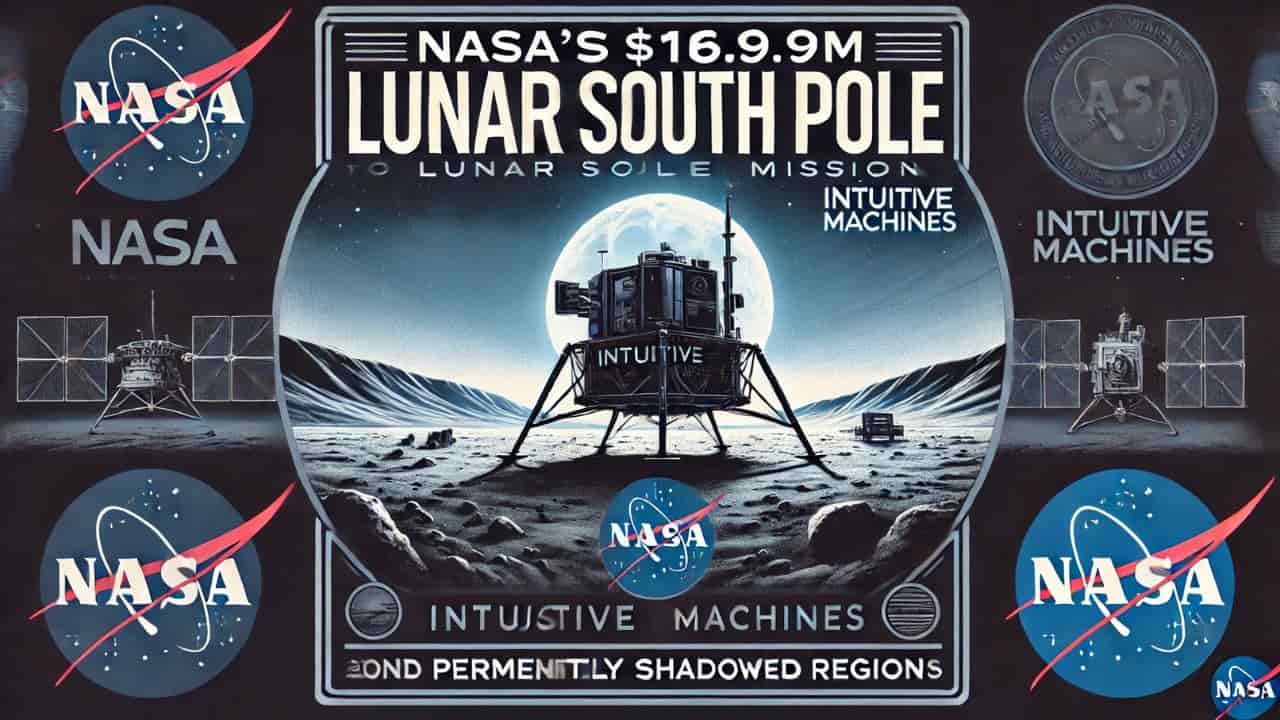NASA, Intuitive Machines, Lunar South Pole, CLPS initiative, Artemis program, lunar exploration, moon research, space technology, lunar missions, NASA contracts, lunar payloads, space science
NASA has awarded a $116.9 million contract to Intuitive Machines to deliver crucial science experiments and technology demonstrations to the lunar South Pole in 2027. This mission, part of NASA’s CLPS initiative under the Artemis program, aims to explore the Moon’s frigid and rugged South Pole, unveiling secrets about the origin of water and advancing our understanding of the lunar environment.

NASA Awards Intuitive Machines a Lunar South Pole Research Delivery Contract
In a groundbreaking move, NASA has awarded Intuitive Machines, a Houston-based company, a contract worth $116.9 million to deliver a new set of science experiments and technology demonstrations to the lunar South Pole in 2027. This mission is part of NASA’s broader Commercial Lunar Payload Services (CLPS) initiative, which is a key component of the Artemis program. The initiative aims to explore the Moon and conduct scientific research that will benefit not only lunar exploration but also future missions to Mars and beyond.
The Significance of the CLPS Initiative
The CLPS initiative is a pivotal aspect of NASA’s Artemis campaign, designed to facilitate the delivery of scientific payloads to various locations on the Moon. This initiative is not only about sending instruments and technology to the lunar surface but also about fostering a commercial market for lunar exploration. By contracting private companies like Intuitive Machines, NASA is encouraging innovation and reducing costs, which is essential for sustainable space exploration.
“This marks the 10th CLPS delivery NASA has awarded, and the fourth planned for delivery to the South Pole of the Moon,” said Joel Kearns, deputy associate administrator for exploration at NASA’s Science Mission Directorate. “By supporting a robust cadence of CLPS flights to a variety of locations on the lunar surface, including two flights currently planned by companies for later this year, NASA will explore more of the Moon than ever before.”
This new delivery mission to the lunar South Pole is especially significant because it will explore one of the most challenging environments on the Moon. The South Pole is characterized by frigid nighttime temperatures, rugged terrain, and permanently shadowed regions. These shadowed regions are of particular interest because they may hold clues to the origin of water in our solar system, which is crucial for both scientific research and future human exploration.
Intuitive Machines and Its Role in Lunar Exploration
Intuitive Machines has been a key player in NASA’s lunar exploration efforts, having already been awarded four task orders under the CLPS initiative. The company’s previous mission, which successfully delivered six NASA payloads to Malapert A in the lunar South Pole region in early 2024, set the stage for this latest contract.
For this new mission, Intuitive Machines will be responsible for every aspect of the delivery, from integrating the payloads and launching them from Earth to ensuring a safe landing on the Moon and managing mission operations. This comprehensive role underscores the trust NASA has placed in the company and highlights the growing importance of commercial partnerships in space exploration.
“The instruments on this newly awarded flight will help us achieve multiple scientific objectives and strengthen our understanding of the Moon’s environment,” said Chris Culbert, manager of the CLPS initiative at NASA’s Johnson Space Center in Houston. “For example, they’ll help answer key questions about where volatiles – such as water, ice, or gas – are found on the lunar surface and measure radiation in the South Pole region, which could advance our exploration efforts on the Moon and help us with continued exploration of Mars.”
The Scientific Payloads and Their Objectives
The upcoming mission will carry six NASA payloads, collectively weighing about 174 pounds (79 kilograms). These payloads have been carefully selected to address key scientific questions and demonstrate new technologies that will be vital for future lunar and Martian exploration. The following are the key instruments that will be delivered to the lunar South Pole:
- Lunar Explorer Instrument for Space Biology Applications (LEISA):
- Managed by NASA’s Ames Research Center, this payload will deliver yeast to the lunar surface to study its response to the Moon’s unique environment, including exposure to radiation and lunar gravity. The data collected will provide valuable insights into how living organisms can survive and thrive in space, which is essential for long-term human space exploration.
- Package for Resource Observation and In-Situ Prospecting for Exploration, Characterization, and Testing (PROSPECT):
- Led by the European Space Agency (ESA), this suite of instruments will drill up to 3.3 feet (1 meter) beneath the lunar surface to extract and analyze samples. The goal is to identify possible volatiles, such as water, ice, or gas, trapped at extremely cold temperatures under the surface. Understanding the availability and distribution of these resources is crucial for future lunar missions, especially those aimed at establishing a sustainable human presence on the Moon.
- Laser Retroreflector Array (LRA):
- Managed by NASA’s Goddard Space Flight Center, this array of eight retroreflectors will enable precise measurements of the distance between a spacecraft and the reflector on the lunar lander. The LRA is a passive optical instrument that will serve as a permanent location marker on the Moon, aiding in navigation and long-term studies of the lunar surface.
- Surface Exosphere Alterations by Landers (SEAL):
- Also managed by NASA Goddard, this instrument will investigate how the lunar surface, or regolith, responds to the physical, thermal, and chemical disturbances caused by a spacecraft landing. It will also assess how contaminants introduced by the lander might affect the composition of samples collected nearby. The findings will be crucial for designing future missions that aim to minimize the impact on the lunar environment.
- Fluxgate Magnetometer:
- This instrument, managed by NASA Goddard, will measure magnetic fields on the lunar surface to improve our understanding of energy and particle interactions at the Moon. The data collected will help scientists better understand the Moon’s magnetic environment, which has implications for both lunar exploration and broader planetary science.
- Lunar Compact Infrared Imaging System (LCIRIS):
- Managed by the Laboratory for Atmospheric and Space Physics at the University of Colorado at Boulder, this system will deploy a radiometer to measure infrared wavelengths of light. The LCIRIS will map the Moon’s surface temperature distribution and explore its composition, providing critical data for future lunar resource utilization activities.
The Broader Impact of CLPS and Artemis
NASA’s CLPS initiative is a cornerstone of the Artemis program, which aims to return humans to the Moon and establish a sustainable presence by the end of this decade. By contracting multiple commercial companies to deliver payloads to different regions of the Moon, NASA is not only advancing lunar science but also laying the groundwork for future human missions.
The scientific experiments and technology demonstrations carried out under CLPS will provide essential data for the Artemis program. For example, the instruments designed to search for water and other volatiles will help determine where resources are most abundant on the Moon, which will be crucial for future human missions that aim to use these resources for life support and fuel.
In addition to supporting human exploration, the CLPS initiative will also contribute to our understanding of the Moon as a scientific destination. By studying the lunar surface, its environment, and its resources, NASA and its commercial partners are helping to answer fundamental questions about the Moon’s history and its potential to support life.
Future Missions and Technological Advancements
The mission awarded to Intuitive Machines is just one of many under the CLPS initiative. Two additional CLPS flights are scheduled to launch by the end of 2024, each carrying a suite of scientific instruments and technology demonstrations to different regions of the Moon. One of these missions, the Intuitive Machines-2 delivery, will mark NASA’s first on-site demonstration of searching for water and other chemical compounds 3.3 feet below the lunar surface, using a drill and mass spectrometer.
These missions represent a new era of lunar exploration, where commercial companies play a central role in advancing science and technology. By leveraging the capabilities of private industry, NASA is accelerating the pace of exploration and ensuring that the Artemis program can achieve its ambitious goals.
As we look ahead to 2027 and beyond, the collaboration between NASA and companies like Intuitive Machines will continue to push the boundaries of what is possible in space exploration. The lessons learned and the technologies developed through these missions will pave the way for a future where humans live and work on the Moon, and eventually, on Mars.
Conclusion
The awarding of this contract to Intuitive Machines marks a significant step forward in NASA’s quest to explore the lunar South Pole and unlock the secrets of the Moon. Through the CLPS initiative, NASA is fostering a new era of commercial space exploration, where private companies play a vital role in advancing science and technology. The data collected and the technologies demonstrated on this mission will not only enhance our understanding of the Moon but also support future human exploration efforts on the Moon, Mars, and beyond.
As the Artemis program progresses, the collaboration between NASA and its commercial partners will be essential in achieving the long-term goal of establishing a sustainable human presence on the Moon. This mission, and others like it, will lay the foundation for a new era of space exploration, where the Moon serves as a stepping stone to the broader solar system.
Read More
- NASA and Sierra Space Dream Chaser Arrives in Florida for Launch Prep
- NASA Webb Telescope Hints at Possible Atmosphere Surrounding Rocky Exoplanet
- NASA’s Select Terrain Vehicle for Artemis Missions
- NASA Seeks Public Input on Future Low Earth Orbit Microgravity Strategy










